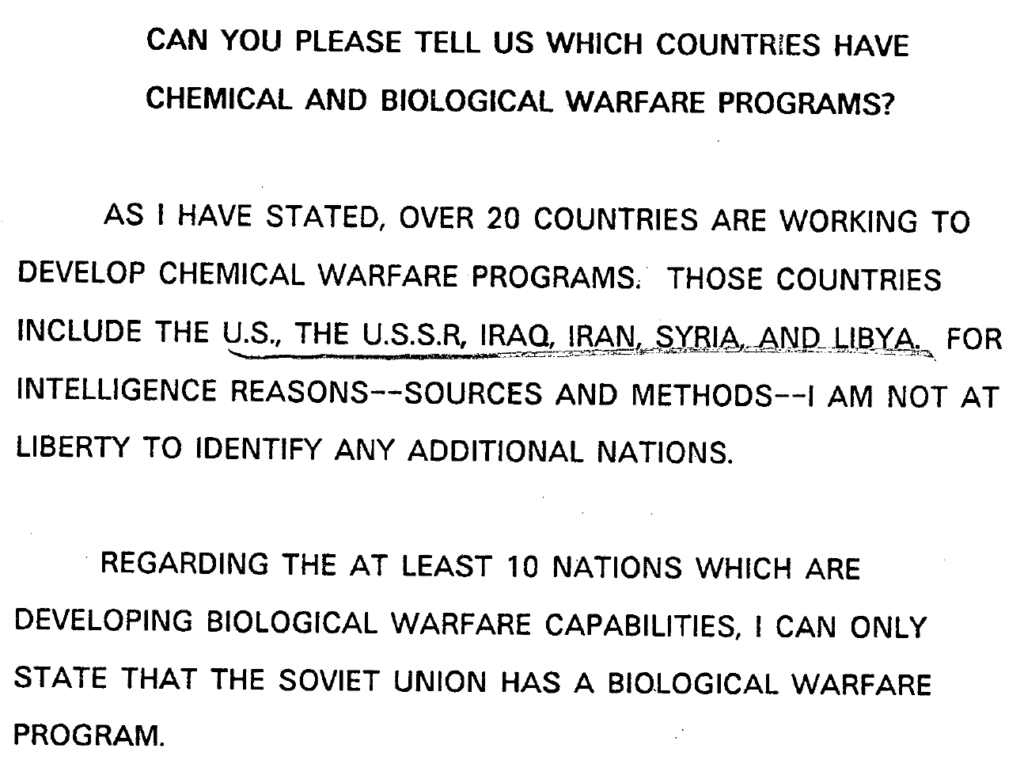Here are 3 recent IAEA INFCIRCs featuring communications from Iran to the agency:
Category Archives: Uncategorized
CIA in 1989 on CBW Proliferation
1989 DCI CBW SFRC Testimony, Redacted
This 1989 briefing book for DCI testimony before the SFRC on CBW issues has some interesting material. I’ll confess to being confused by the redacted portions of open testimony, especially because this paragraph is on the cover page:

This is the portion to which I’m referring. I’m sure there’s a reason.
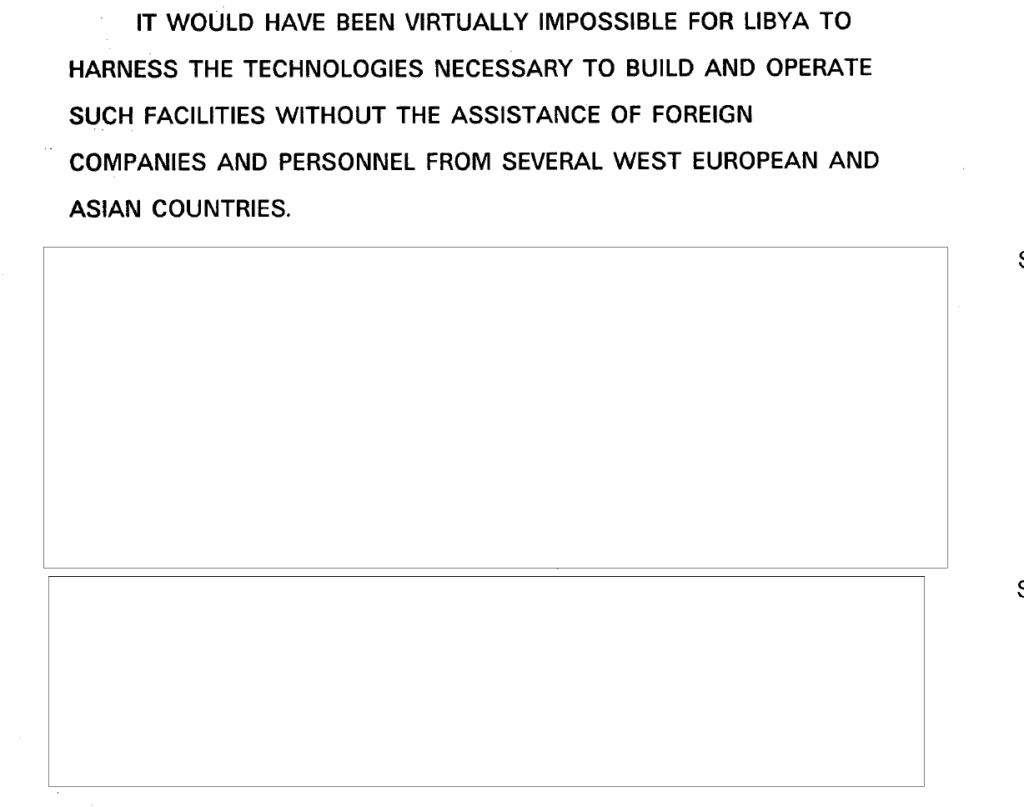
Tyler Drumheller and South African Nukes, 2020 Edition
I wrote this a while back, too.
I’m finally getting around to posting a tidbit I found a while back in Tyler Drumheller’s On the Brink: An Insider’s Account of How the White House Compromised American Intelligence.
I am referring to the assertion that, when Drumheller was a CIA operative in South Africa, his sources
provided incontrovertible evidence that the apartheid government had in fact tested a nuclear bomb in the south Atlantic in 1979, and that they had developed a delivery system with assistance from the Israelis.
I really wish Drumheller had provided more detail about this evidence, which sounds a lot more concrete than the Vela satellite evidence. Obviously, a debate still rages about South Africa’s alleged test and cooperation with the Israelis, so more information would be welcome.
T Drumheller on Email Etiquette, 2020 Edition
I thought I remembered writing this:
In Tyler Drumheller’s On the Brink: An Insider’s Account of How the White House Compromised American Intelligence, the author (as many of you know) recounts the contentious email discussion within the IC about the validity of the Iraqi informant named Curveball.
The whole tale is pretty entertaining, but I particularly like the part where he mentions that he once had to tell one of his colleagues “that it might not be such a good idea to put ‘fuck you’ in an email.”
Happy Monday.
South Africa and Chinese-Sponsored Nuclear Terrorism
The appendix to this 2004 NPR article contains a South African document which cites the possibility that a terrorist organization “could acquire and launch against us a tactical nuclear weapon” acquired from China.
The authors explain here:
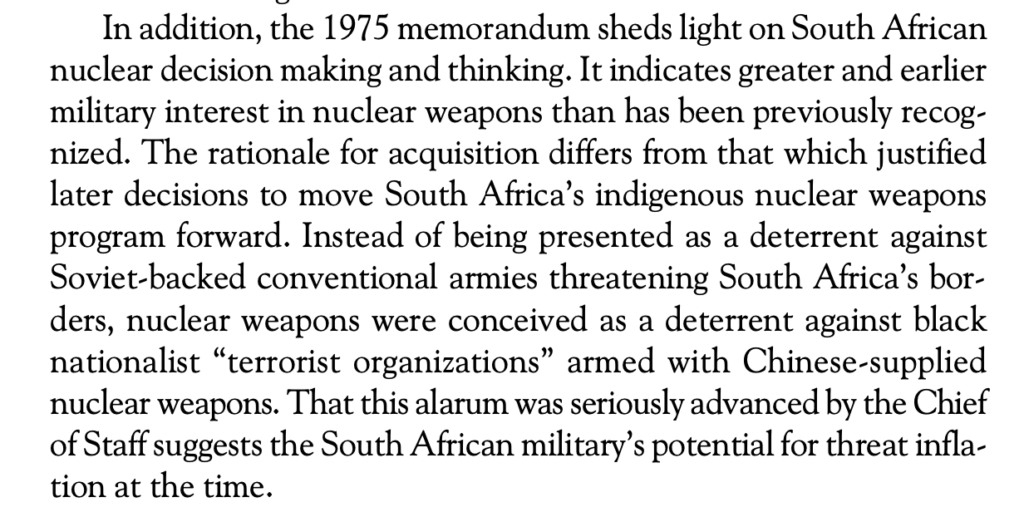
<snip>
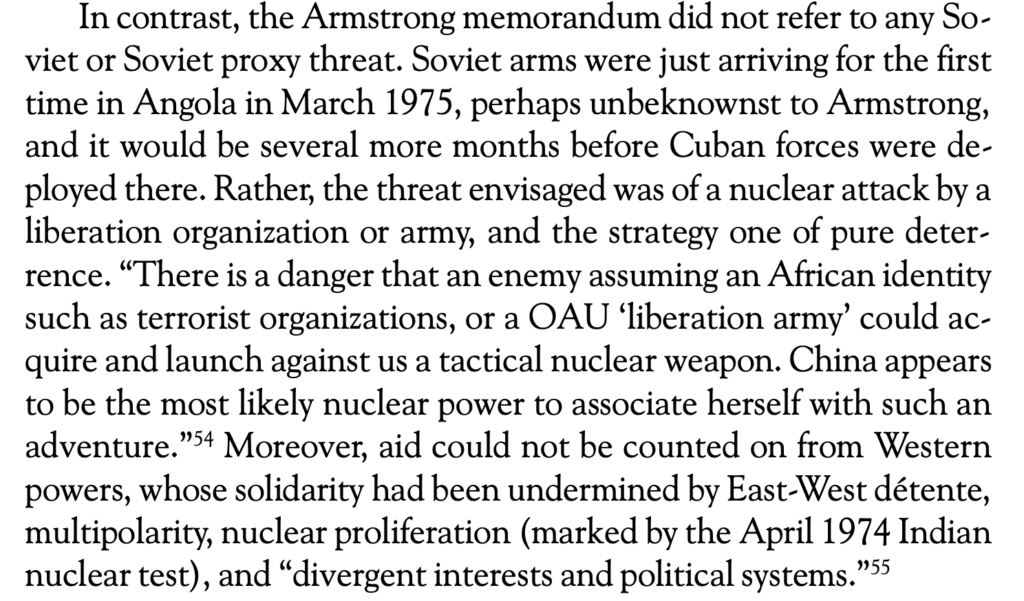
<snip>
The article makes clear that this view appears not to have been widespread within the South African government:
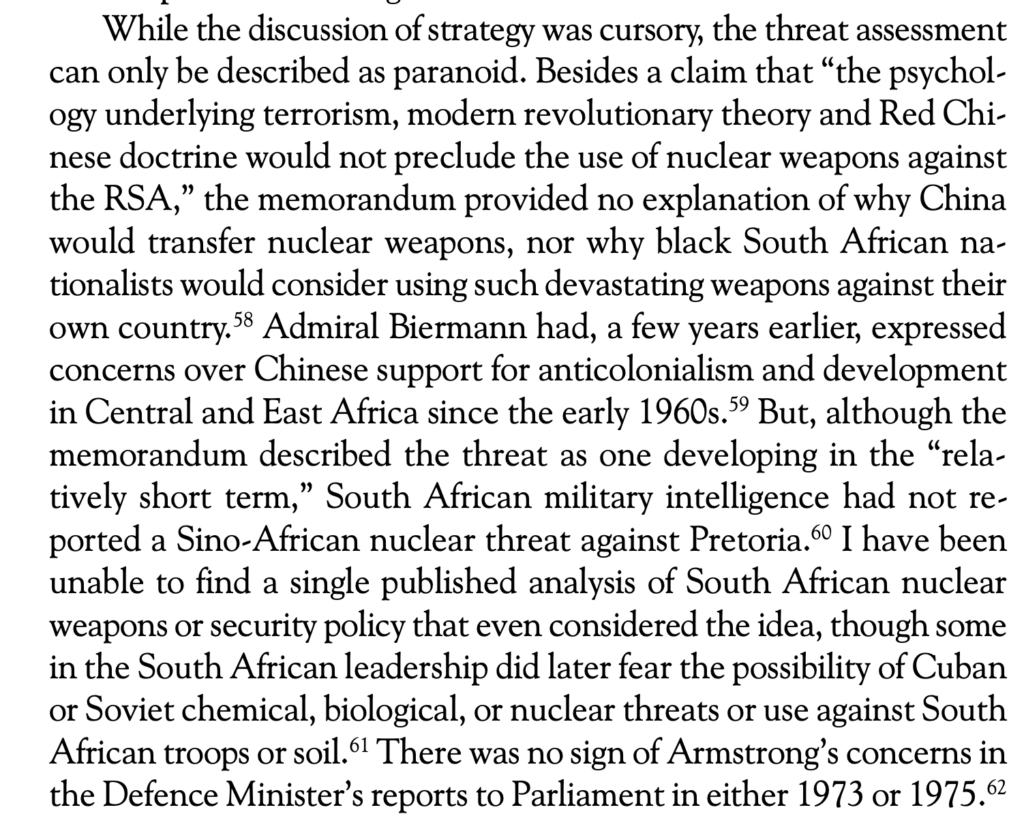
Tyler Drumheller on South Africa and Nuclear Weapons
I ran across this post based on a series of 2010 interviews with Tyler Drumheller in which he discussed South Africa’s nuclear weapons program:
During our interviews, he reflected on earlier experiences in his career. In 1980, “we had 11 case officers in South Africa, four of them with deep cover.” They had penetrated the apartheid regime’s “Project Circle,” which was already within reach of perfecting a usable, deliverable atomic bomb.
“We were regularly able to obtain swipe samples from its enrichment facilities. We could monitor progress,” Drumheller told me.
They also monitored the deep cover “black station” of Israel’s intelligence agency, the Mossad. Drumheller said this was a front company called TamCo. The Israelis had no idea they were under such close U.S. scrutiny.
Washington had tried to impede Pretoria’s effort by embargoing the shipment of a VAX computer from Massachusetts-based Digital Equipment Corporation. “Project Circle needed that VAX” to complete the project, Drumheller said.
The CIA station in Pretoria learned that South Africa was able to get around the embargo by having the computer — the same powerful VAX model — transshipped from the United States. “It came via the Israelis and TamCo,” Drumheller said.
[snip]
The CIA was able to obtain these and other details about the Israeli-South African collusion, Drumheller explained, from a stellar agent that the CIA had placed within Project Circle.
P Pillar on Politicization
Here’s more from the PBS interview with Paul Pillar that I cited the other day. He discusses the politicization of intelligence.
A lot of intelligence analysts were caught up in several things: a previous consensus against which there just wasn’t enough intelligence to challenge it; the consensus being that yes, there were programs. The atmosphere in which they were working, in which a policy decision clearly had already been made, in which intelligence was being looked to to support that decision rather to inform decisions yet to be made, was a very important part of the atmosphere.
Exactly how that may have affected the individual judgments of particular analysts, it’s impossible to say. It probably had some effect, particularly since most of the shortcomings of the analysis we’re talking about come down to matters of nuance, caveat — whether the language is too strong, that sort of thing. There were many, many opportunities for things to be shaded in the preferred direction rather than in another direction.
<snip>
Politicization, real politicization, rarely works that way; that is to say a blatant, crude arm twisting. It’s always far more subtle. It would take the form either of these almost subconscious or subliminal adjustments that dozens of analysts might make in the course of phrasing their judgments, making it a little less nuanced, a little less caveated, which I think is the main basis for criticizing the judgments on weapons of mass destruction in Iraq.
It can take the form of … intelligence assessments that conform with what is known to be the policy having an easier time making it through … than assessments that don’t supply the policy. … This wasn’t an inquiry into how can Iraq threaten the United States; it wasn’t an inquiry into what are Al Qaeda sources of support. It instead was basically research in support of a specific line of argument. That, I think, qualifies for the label “politicization,” even if analysts are doing their best job to maintain their analytic integrity when they make their individual judgments. …
This description echoes other assessments of the politicization of intelligence that most of us have likely read. But I think it’s good to have another data point, especially from Dr. Pillar.
CIA (Suspected) Nuke Test Evaluation, 1997
This is a CIA “assessment of what occurred at the Novaya Zemlya test site area” in August 1997. Here’s Tenet’s summary:
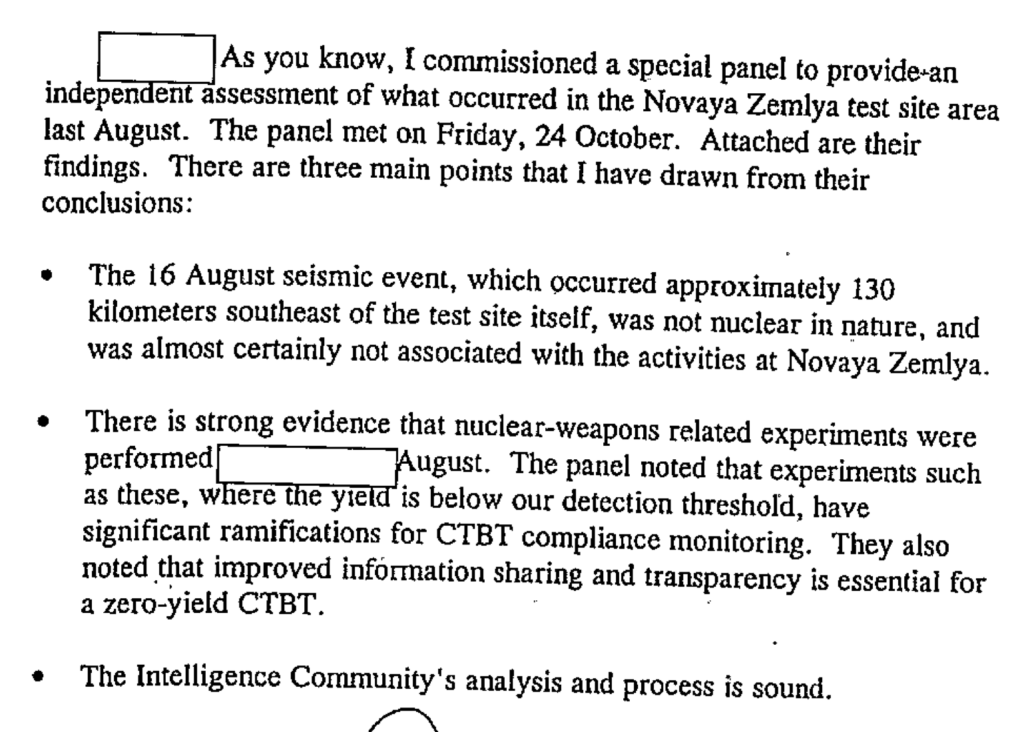
But I think this part is pretty interesting…if I’m reading it correctly, the below excerpt explains agency procedures which, at least at the time, required analysts to err on the side of caution when assessing possible nuclear tests.
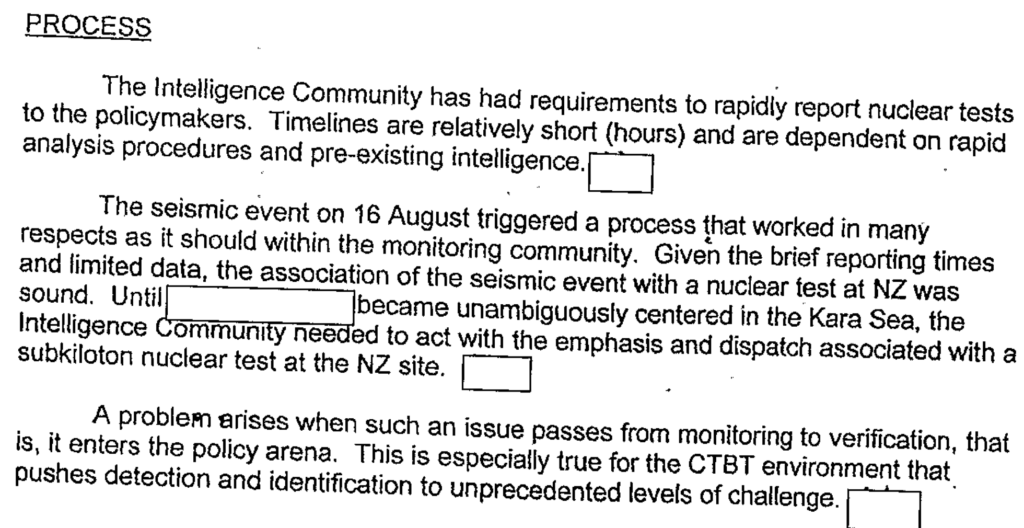
P.Pillar on 2007 Iran NIE
While looking for something else, I came across this piece by Gareth Porter, which has some good primary source material on the Iran NIE.
For example, this section has some material based on interviews with Paul Pillar:
Robert D. Walpole, the national intelligence officer for strategic and nuclear programs and formerly a weapons analyst in WINPAC’s predecessor, the [CIA Nonproliferation Center], had the lead in the 2001 estimate. That meant that he would determine what would be included in the first draft, as Pillar observed.13 WINPAC’s technical analysts dominated the process, writing not only about Iran’s capabilities in regard to possible nuclear weapons but also the crucial section on Iran’s nuclear intentions, according to Pillar, even though that was not their expertise.14 Those analysts who had the expertise to assess Iran’s intent in light of the full range of evidence were again sidelined.
Pillar recalled that the basis for the [2001 NIE’s] conclusion that Iran intended to go to nuclear weapons was “a matter of inference, not direct evidence.”15 Pillar and other analysts believed that the Iranian regime had not made a decision to build nuclear weapons and that Iran’s decision on manufacturing nuclear weapons would be especially influenced by United States policy — particularly whether the United States pursued an aggressive policy toward Iran or was willing to offer security assurances to Tehran. Citing pragmatic arguments made by Iranian officials against possession of nuclear weapons, among other indications, they argued that Iran was pursuing a “hedging strategy” aimed at having the technical know-how and capability to acquire nuclear weapons but refraining from a decision to proceed with a nuclear program for the indefinite future. But the WINPAC analysts tended to be uninterested in such arguments, according to Pillar: “Some of them would say, ‘Don’t give me that Iranian-decision-yet-to-be-made approach. They’ve already decided!'”16
Because two dramatically different points of view had been expressed during the discussion of the draft, the participants either had to agree on compromise language or to register fundamental disagreement on the conclusions. The negotiations focused on the order of key sentences representing the two competing conclusions. The side that prevailed got its conclusions into the very first two sentences, Pillar said, whereas the competing conclusion might only appear in the third paragraph.17
<snip>
Essentially the same dynamics were repeated in the 2005 NIE on Iran’s nuclear program. WINPAC analysts reaffirmed their previous assessments about the Iranian nuclear program. And Pillar and other country and regional analysts again argued that Iran had not made any decision to weaponize and was engaging in a “hedging” strategy. The first sentence of the key conclusions in the 2005 estimate assessed “[w]ith high confidence that Iran currently is determined to develop nuclear weapons despite its international obligations and international pressure, but we do not assess that Iran is immovable.”20 Despite the “high confidence” claimed in that conclusion, however, no evidence had come to light of any Iranian nuclear-weapons design work, according to Pillar.21

